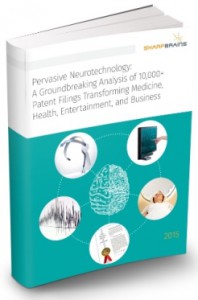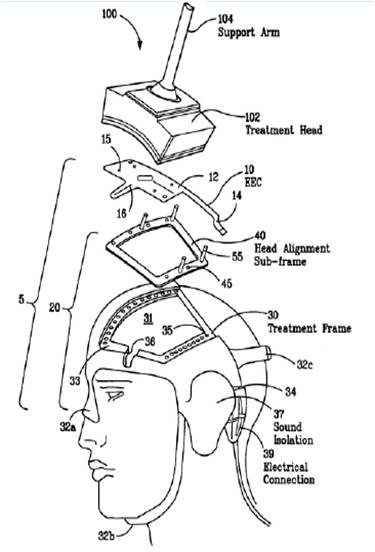Facilitating clinical treatments via Transcranial Magnetic Stimulation (TMS): Key Neurotechnology Patent #21
Today we are sharing a key 2005 patent assigned to Neuronetics, Inc. (As mentioned, we are featuring a foundational Pervasive Neurotech patent a day, from older to newer by issue date)
U.S. Patent No. 6,926,660: Facilitating treatment via magnetic stimulation.
- Assignee(s): Neuronetics, Inc.
- Inventor(s): Stanford W. Miller
- Technology Category: Transcranial Stimulation
- Issue Date: August 9, 2005
SharpBrains’ Take:
TMS treatments procedures are more effective and efficient if targeted stimulation to the patient can be quickly and easily repeated, rather than blindly hunting for the correct location and orientation after initial dosing/ testing procedures conducted to determine the appropriate stimulation field strength and location. The ‘660 patent discloses techniques that replace previous techniques for re-positioning patients with stimulation devices by using a mechanism that considers and adjusts to the patient’s head contours and the treatment device. The fixed, wearable nature of the apparatus described in the ‘660 patent provides a relatively low cost stimulation alignment and orientation system (compared to other stimulation techniques that, for example, may involve expensive robotics). The importance of precision and targeted treatment in stimulation treatment procedures, the potentially low cost alternative to other targeted stimulation approaches and the broadly claimed inventive concept are among the contributing factors that make the ‘660 patent a key non-invasive neurotechnology patent.
Abstract:
The invention provides a device, system and method for placing a treatment component on a patient’s head. The inventive device includes an attachment frame that attaches the treatment component to the patient’s head. The attachment frame also includes a window. A receiving mechanism holds the treatment component to the attachment frame, and an alignment structure permits the treatment component to be positioned at a desired location on the patient’s head. The inventive device also may include an isolator component capable of reducing sound to the patient’s ears and/or reducing vibration of the attachment frame. The inventive may also include an electrical connector to send and receive data based on the treatment, and an adjustment structure that is capable of adjusting the device to each patient.
Illustrative Claim 22. A method of placing a treatment device on a patient, comprising:
- placing a head-frame component on the patient’s head;
- aligning the head-frame component to the patient’s head;
- securing the head-frame component to the patient;
- attaching a treatment device to the head-frame component; and
- adjusting the device to the contours of an individual patient’s head.
 To learn more about market data, trends and leading companies in the digital brain health space –digital platforms for brain/ cognitive assessment, monitoring and enhancement– check out this market report. To learn more about our analysis of 10,000+ patent filings, check out this IP & innovation neurotech report.
To learn more about market data, trends and leading companies in the digital brain health space –digital platforms for brain/ cognitive assessment, monitoring and enhancement– check out this market report. To learn more about our analysis of 10,000+ patent filings, check out this IP & innovation neurotech report.



